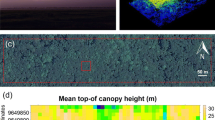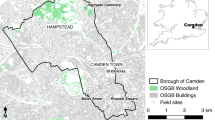Abstract
In this study, we evaluated methods for reliably estimating leaf area index (LAI) and gap fraction in two different types of broad-leaved forests by the use of airborne light detection and ranging (LiDAR) data. We evaluated 13 estimation variables related to laser height, laser penetration rate, and laser point attributes that were derived from LiDAR analyses. The relationships between LiDAR-derived estimates and field-based measurements taken from the forests were evaluated with simple linear regressions. The data from the two forests were analyzed separately and as an integrated dataset. Among the laser height variables, the coefficient of variation (CV) of all laser point heights had the highest level of accuracy for estimating both LAI and gap fraction. However, we recommend that more evaluations be conducted prior to the use of CV in forests with complex structures. The simplest laser penetration variable, which represents the ratio of the number of ground points to the total number of all points (P ALL), also had a high level of accuracy for estimating LAI and gap fraction at the study sites regardless of whether the data were analyzed separately or as an integrated data set. Furthermore, P ALL values showed near 1:1 relationships with the field-based gap fraction values. Hence, the use of P ALL may be the most practical for estimating LAI and gap fraction in broad-leaved forests, even when the canopies are heavily closed.




Similar content being viewed by others
References
Baltsavias EP (1999) A comparison between photogrammetry and laser scanning. ISPRS J Photogramm 54:83–94
Bater CW, Coops NC, Gergel SE, LeMay V, Collins D (2009) Estimation of standing dead tree class distributions in northwest coastal forests using lidar remote sensing. Can J Forest Res 39:1080–1091
Carlson TN, Ripley DA (1997) On the relation between NDVI, fractional vegetation cover, and leaf area index. Remote Sens Environ 62:241–251
Chen JM, Cihlar J (1996) Retrieving leaf area index of boreal conifer forests using Landsat TM images. Remote Sens Environ 55:153–162
Cohen WB, Maiersperger TK, Gower ST, Turner DP (2003) An improved strategy for regression of biophysical variables and Landsat ETM + data. Remote Sens Environ 84:561–571
Colombo R, Bellingeri D, Fasolini D, Marino CM (2003) Retrieval of leaf area index in different vegetation types using high resolution satellite data. Remote Sens Environ 86:120–131
Coops NC, Hilker T, Wulder MA, St-Onge B, Newnham G, Siggins A, Trofymow JA (2007) Estimating canopy structure of Douglas-fir forest stands from discrete-return LiDAR. Trees Struct Funct 21:295–310
Donoghue DNM, Watt PJ, Cox NJ, Wilson J (2007) Remote sensing of species mixtures in conifer plantations using LiDAR height and intensity data. Remote Sens Environ 110:509–522
Hardin PJ, Jensen R (2007) The effect of urban leaf area on summertime urban surface kinetic temperatures: a Terre Haute case study. Urban For Urban Gree 6:63–72
Hopkinson C, Chasmer L (2009) Testing LiDAR models of fractional cover across multiple forest ecozones. Remote Sens Environ 113:275–288
Jensen JLR, Humes KS, Vierling LA, Hudak AT (2008) Discrete return lidar-based prediction of leaf area index in two conifer forests. Remote Sens Environ 112:3947–3957
Jonckheere I, Fleck S, Nackaerts K, Muys B, Coppin P, Weiss M, Baret F (2004) Review of methods for in situ leaf area index determination: part I. Theories, sensors and hemispherical photography. Agric Forest Meteorol 121:19–35
Korhonen L, Korpela I, Heiskanen J, Maltamo M (2011) Airborne discrete-return LIDAR data in the estimation of vertical canopy cover, angular canopy closure and leaf area index. Remote Sens Environ 115:1065–1080
Lefsky MA, Cohen WB, Parker GG, Harding DJ (2002) Lidar remote sensing for ecosystem studies. Bioscience 52:19–30
Lim KS, Treitz PM (2004) Estimation of above ground forest biomass from airborne discrete return laser scanner data using canopy-based quantile estimators. Scand J Forest Res 19:558–570
Miura N, Jones SD (2010) Characterizing forest ecological structure using pulse types and heights of airborne laser scanning. Remote Sens Environ 114:1069–1076
Morimoto Y, Njoroge JB, Nakamura A, Sasaki T, Chihara Y (2006) Role of the EXPO ‘70 forest project in forest restoration in urban areas. Lands Ecol Eng 2:119–127
Morsdorf F, Kotz B, Meier E, Itten KI, Allgower B (2006) Estimation of LAI and fractional cover from small footprint airborne laser scanning data based on gap fraction. Remote Sens Environ 104:50–61
Muraoka H, Koizumi H (2005) Photosynthetic and structural characteristics of canopy and shrub trees in a cool-temperate deciduous broadleaved forest. Agric Forest Methodol 134:39–59
Næsset E, Gobakken T (2008) Estimation of above- and below-ground biomass across regions of the boreal forest zone using airborne laser. Remote Sens Environ 112:3079–3090
Nakamura A, Morimoto Y, Mizutani Y (2004) Adaptive management approach to increasing the diversity of a 30-year-old planted forest in an urban area of Japan. Landsc Urban Plan 70:291–300
Nelson R, Krabill W, Tonelli J (1988) Estimating forest biomass and volume using airborne laser data. Remote Sens Environ 24:247–267
Nemani RR, Running SW (1989) Testing a theoretical climate-soil-leaf area hydrologic equilibrium of forests using satellite data and ecosystem simulation. Agric Forest Methodol 44:245–260
Norman JM, Campbell GS (1989) Canopy structure. In: Pearcy RW, Ehleringer JR, Mooney HA, Rundel PW (eds) Plant physiological ecology: field methods and instrumentation. Chapman and Hall, London, pp 301–325
Packalén P, Maltamo M (2006) Predicting the plot volume by tree species using airborne laser scanning and aerial photographs. Forest Sci 52:611–622
Popescu SC, Wynne RH, Nelson RF (2002) Estimating plot-level tree heights with lidar: local filtering with a canopy-height based variable window size. Comput Electron Agr 37:71–95
R Development Core Team (2011) R: a language and environment for statistical computing. R Foundation for Statistical Computing, Vienna. ISBN: 3-900051-07-0. http://www.R-project.org
Riaño D, Valladares F, Condes S, Chuvieco E (2004) Estimation of leaf area index and covered ground from airborne laser scanner (Lidar) in two contrasting forests. Agric Forest Methodol 124:269–275
Richardson JJ, Moskal LM, Kim SH (2009) Modeling approaches to estimate effective leaf area index from aerial discrete-return LIDAR. Agric Forest Methodol 149:1152–1160
Sasaki T, Imanishi J, Ioki K, Morimoto Y, Kitada K (2008) Estimation of leaf area index and canopy openness in broad-leaved forest using airborne laser scanner in comparison with high-resolution near-infrared digital photography. Landsc Ecol Eng 4:47–55
Satake Y, Hara H, Watari S, Tominari T (1989) Wild flowers of Japan: woody plants I and II, 1st edn. Heibonsha Ltd. Publishers, Tokyo
Solberg S, Brunner A, Hanssen KH, Lange H, Næsset E, Rautiainen M, Stenberg P (2009) Mapping LAI in a Norway spruce forest using airborne laser scanning. Remote Sens Environ 113:2317–2327
Spanner MA, Pierce LL, Running SW, Peterson DL (1990) The seasonality of AVHRR data of temperate coniferous forests: relationship with leaf area index. Remote Sens Environ 33:97–112
Takenaka A (2009) CanopOn2. http://takenaka-akio.cool.ne.jp/etc/canopon2/. Accessed 25 July 2012
Acknowledgments
We wish to acknowledge the staff of the Commemorative Organization for the Japan World Exposition ‘70 and Japanese Imperial Household Agency for their support in field observation.
Author information
Authors and Affiliations
Corresponding author
Rights and permissions
About this article
Cite this article
Sasaki, T., Imanishi, J., Ioki, K. et al. Estimation of leaf area index and gap fraction in two broad-leaved forests by using small-footprint airborne LiDAR. Landscape Ecol Eng 12, 117–127 (2016). https://doi.org/10.1007/s11355-013-0222-y
Received:
Revised:
Accepted:
Published:
Issue Date:
DOI: https://doi.org/10.1007/s11355-013-0222-y




